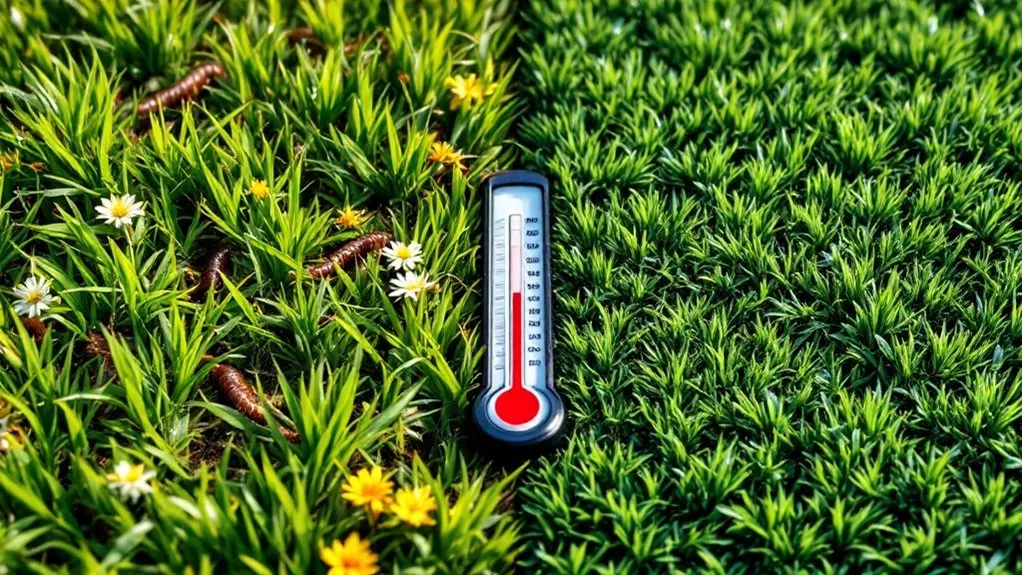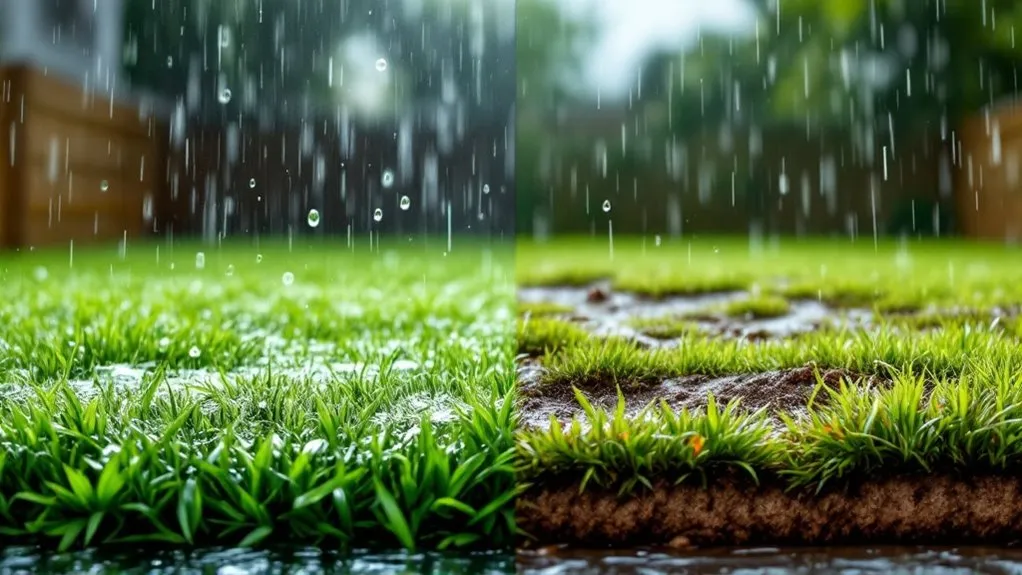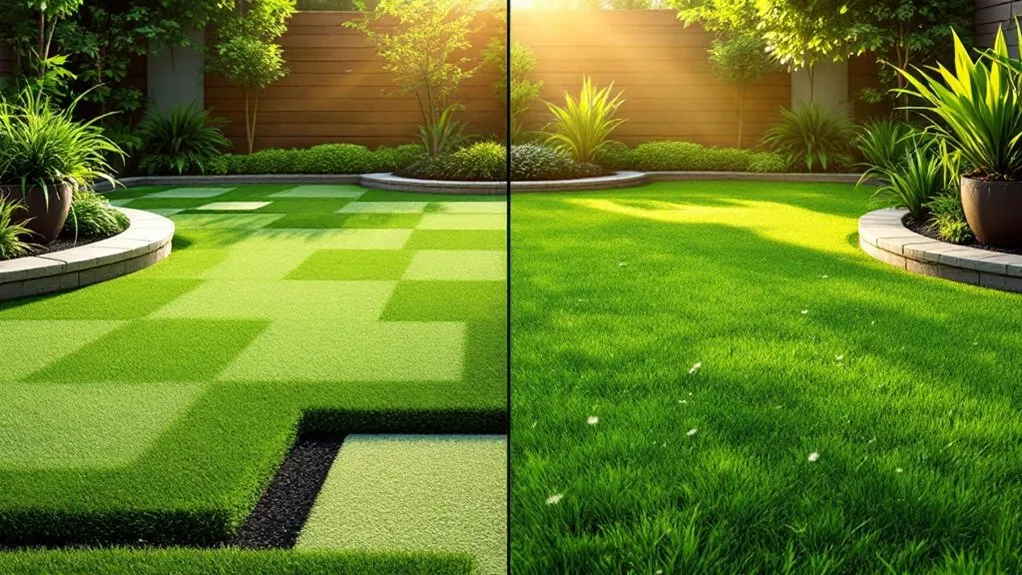The choice between artificial turf and natural grass depends on your needs and circumstances. Artificial turf offers higher upfront costs ($750,000-$1.2M) but lower annual maintenance ($5,000-$10,000), while natural grass provides lower installation costs ($200,000-$300,000) with higher yearly upkeep ($25,000-$35,000). You must evaluate water conservation, climate suitability, safety requirements, and aesthetic preferences. Each option presents distinct advantages that warrant careful analysis of your unique situation.
Key Takeaways
- Artificial turf has higher upfront costs ($750,000-$1.2M) but lower annual maintenance ($5,000-$10,000) than natural grass’s lifecycle expenses.
- Natural grass requires extensive water usage (56,000 gallons annually), while artificial turf needs minimal irrigation for occasional cleaning.
- Artificial turf maintains a consistent appearance year-round and withstands heavy use, while natural grass needs recovery periods after stress.
- Natural grass provides better shock absorption and temperature regulation, making it safer for high-impact sports and activities.
- Climate considerations are crucial: artificial turf excels in arid regions, while natural grass performs better in temperate zones.
Initial Cost Comparison: Breaking Down the Numbers

The initial investment required for artificial turf installation considerably exceeds that of natural grass, with synthetic fields typically costing between $750,000 to $1.2 million for a standard football field size of 80,000 square feet.
You must factor in site preparation, drainage systems, and specialized installation labor when conducting your initial investment breakdown.
While natural grass requires only $200,000 to $300,000 for initial setup, an all-encompassing cost-benefit analysis must consider long-term maintenance expenses.
You’re fundamentally paying more upfront for artificial turf to potentially save on recurring costs like water, mowing, fertilization, and field restoration over the installation’s lifespan.
Long-Term Maintenance Requirements and Expenses
While artificial turf‘s higher upfront costs can deter potential buyers, annual maintenance expenses typically range from $5,000 to $10,000 per field – considerably less than natural grass‘s $25,000 to $35,000 yearly upkeep.
Your cost projections for turf maintenance should account for periodic brushing, debris removal, and occasional disinfecting. You’ll save notably on water, fertilizer, and mowing equipment compared to natural grass. However, you’ll need specialized tools for routine upkeep of artificial surfaces.
With natural grass, you face continuous mowing, watering, fertilizing, and reseeding costs.
Weather damage and heavy use often require extensive repairs, increasing long-term expenses.
Environmental Impact and Sustainability Factors

When you compare water conservation between artificial turf and natural grass, you’ll find that synthetic fields require minimal irrigation beyond occasional cleaning. In contrast, natural grass demands frequent watering cycles throughout growing seasons.
Your analysis of carbon footprints must account for the petroleum-based materials and manufacturing processes of artificial turf against the carbon-sequestering capabilities of living grass.
You’ll need to weigh these environmental tradeoffs alongside considerations like artificial turf’s 8-10-year replacement cycle versus natural grass’s continuous regeneration through proper maintenance.
Water Usage Comparison
Considering long-term environmental sustainability, natural grass requires substantially more water consumption than artificial turf – typically 50,000 to 100,000 gallons annually per athletic field.
You’ll find that artificial turf eliminates regular irrigation, contributing considerably to water conservation efforts.
While natural grass demands consistent watering schedules and sophisticated irrigation systems to maintain its health, artificial surfaces require only occasional cleaning with minimal water.
Even with advanced irrigation efficiency technologies, natural grass can’t match synthetic turf’s water-saving benefits.
In drought-prone regions, this difference becomes particularly vital when evaluating your long-term environmental impact and utility costs.
Carbon Footprint Analysis
Although artificial turf reduces water consumption, its carbon footprint presents a more complex environmental equation.
When you install synthetic turf, you’ll need to evaluate its petroleum-based materials and manufacturing process, contributing to greenhouse gas emissions.
Natural grass, however, offers carbon sequestration benefits through photosynthesis and soil carbon storage.
Your environmental footprint calculation must factor in the turf’s 8-10-year lifespan, disposal challenges, and heat island effects.
Natural grass requires regular mowing and maintenance emissions but provides ecosystem services like oxygen production and temperature regulation.
The choice depends on your specific context and environmental priorities.
Water Conservation and Usage Considerations
Regarding water consumption, natural grass, and artificial turf represent opposing ends of the maintenance spectrum.
While natural lawns require consistent irrigation, but artificial turf is one of today’s leading solutions to water scarcity. You’ll find significant differences in water requirements:
- Natural grass typically needs 1-1.5 inches of water weekly
- Artificial turf requires only occasional cleaning rinses
- A 1,800 sq ft lawn uses approximately 56,000 gallons annually
- Switching to synthetic turf can reduce water consumption by up to 99%
As irrigation alternatives become vital in drought-prone regions, artificial turf’s minimal water demands present a compelling advantage over traditional grass maintenance.
Durability and Weather Resistance Analysis

When evaluating artificial turf against natural grass, you’ll find that synthetic surfaces withstand severe weather conditions with minimal degradation over 8-10 years. In contrast, natural grass requires constant recovery from extreme temperatures and precipitation.
Laboratory stress testing demonstrates that quality artificial turf maintains its structural integrity under 20,000+ cycles of simulated foot traffic, outperforming natural grass in high-traffic conditions.
Your long-term resistance analysis must account for UV exposure, which can reduce artificial turf’s tensile strength by 15-20% over its lifespan, whereas natural grass continuously regenerates despite environmental stressors.
Weather Impact Over Time
Artificial turf and natural grass experience distinct responses to weather conditions over extended periods.
You’ll notice that weather patterns significantly affect their longevity and performance characteristics. Natural grass adapts to seasonal changes but requires recovery periods, while artificial turf maintains a consistent appearance regardless of conditions.
Key weather impacts on both surfaces over time:
- UV radiation causes artificial turf fibers to fade and become brittle gradually.
- Freeze-thaw cycles can damage both surface types’ underlying structures.
- Heavy rainfall tests drainage capabilities differently in each system.
- Extended heat exposure affects artificial turf’s surface temperature more severely.
These factors influence your maintenance requirements and replacement timeline for either surface choice.
Stress Testing Results
Through extensive laboratory and field testing, artificial turf and natural grass surfaces demonstrate distinct durability characteristics under controlled stress conditions.
You’ll find that artificial turf consistently outperforms natural grass in durability testing, maintaining its structural integrity after 20,000+ hours of simulated use.
However, user feedback indicates that natural grass provides superior shock absorption and less surface hardening over time.
Your choice between these surfaces should consider that artificial turf’s stress resistance remains constant year-round, while natural grass’s resilience fluctuates with seasonal changes and recovery periods.
Recent studies show artificial turf retains 95% of its performance properties after eight years of heavy use.
Long-Term Resistance Comparison
The long-term resistance patterns of artificial turf and natural grass extend beyond basic stress testing into thorough weather exposure analysis.
When evaluating longevity expectations, you’ll find distinct performance metrics between these surfaces.
Key resistance factors include:
- UV radiation tolerance – artificial turf maintains color for 8-10 years, while natural grass self-regenerates
- Freeze-thaw cycle impact – synthetic surfaces resist frost damage better
- Drainage capacity – artificial turf drains 10x faster after heavy rain
- Temperature fluctuation response – natural grass provides 30% better temperature regulation
These metrics directly influence your maintenance requirements and determine each surface’s sustainable performance.
Safety and Health Implications for Users
While artificial turf and natural grass each present distinct safety considerations, research shows significant differences in their health implications for athletes and recreational users.
Natural grass provides better shock absorption and reduces joint stress, preventing injury during high-impact activities. However, artificial turf offers consistent playing conditions year-round, eliminating hazards from muddy or uneven surfaces.
From a user-health perspective, natural grass doesn’t retain heat like synthetic surfaces and releases beneficial negative ions.
Yet artificial turf eliminates exposure to pesticides and fertilizers commonly used in grass maintenance. You’ll need to weigh these factors based on your specific usage requirements.
Aesthetic Appeal and Design Flexibility

Despite ongoing debates about performance characteristics, artificial turf, and natural grass offer distinct aesthetic advantages that influence landscape design decisions.
With artificial turf, you’ll have expanded design options and color selection flexibility that natural grass can’t match.
Key artificial turf design advantages include:
- Multiple shade variations to match your aesthetic preferences
- Custom patterns and logos can be permanently incorporated
- Consistent appearance year-round, regardless of climate
- Ability to install in challenging spaces like slopes or shade
Natural grass provides an authentically organic look with seasonal color changes, but you’re limited to available grass species suitable for your climate zone.
Climate Zone Suitability and Performance
Since climate zones significantly impact landscape performance, understanding how artificial turf and natural grass respond to different environmental conditions is essential for making an informed choice.
Artificial turf maintains consistent performance metrics in arid regions, while natural grass struggles with water restrictions. However, natural grass demonstrates superior climate adaptation and seasonal responsiveness in temperate zones.
Your artificial turf will perform uniformly across most climate zones but can get uncomfortably hot in extreme temperatures.
Natural grass excels in regions with moderate rainfall and temperatures, though it’s more susceptible to climate-related stress.
Consider your local weather patterns when weighing these options.
Frequently Asked Questions
Can Pets Safely Use Artificial Turf Without Causing Damage or Odors?
Your pets can safely use artificial turf when proper precautions are taken.
The key is choosing pet-specific turf with enhanced drainage and antimicrobial backing for ideal pet safety.
You must maintain proper odor control through regular cleaning and deodorizing treatments.
While pets won’t damage quality artificial turf, you should rinse waste areas promptly and perform monthly deep cleaning to prevent lingering smells and maintain the turf’s integrity.
How Long Does It Take to Complete a Typical Artificial Turf Installation?
Depending on your yard’s size and complexity, your artificial turf installation timeline typically ranges from 2-5 days.
The project duration breaks down into distinct phases: ground preparation (1-2 days), base installation (1 day), turf laying (1 day), and final detailing (1 day).
You’ll need to factor in additional time to remove existing grass or address drainage issues.
Weather conditions can also impact your installation schedule.
Will Artificial Turf Increase or Decrease My Property’s Resale Value?
You’ll typically see a positive impact on your property value with artificial turf, as it enhances curb appeal and reduces maintenance costs.
In today’s resale market, environmentally conscious features are increasingly attractive to buyers. You’ll likely recoup 50-70% of your initial investment through increased home value.
However, market appreciation varies by region, with drought-prone areas showing higher returns due to water conservation benefits and reduced landscaping expenses.
Can I Install Artificial Turf Myself, or Must I Hire Professionals?
While DIY artificial turf installation is possible, it’s a complex project requiring specific tools and expertise.
You’ll need to properly prepare the base, guarantee correct drainage, and precisely cut and seam the turf.
Cost comparison shows DIY can save 40-50% on installation costs, but mistakes can be expensive to fix.
Unless you’re highly skilled in landscaping and have access to specialized equipment, you’ll achieve better results by hiring professionals for this technical installation.
Does Artificial Turf Get Too Hot During Summer Months for Comfortable Use?
Artificial turf can become considerably hotter than natural grass during summer months, potentially reaching temperatures 40-60°F higher than ambient air.
You’ll need to take into account heat management strategies for comfortable use. Standard cooling solutions include installing light-colored infill, using irrigation systems, or applying specialized cooling sprays.
If you’re concerned about heat, you might want to schedule activities during more incredible hours or implement shade structures over high-traffic areas.
